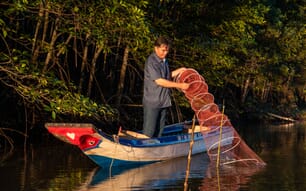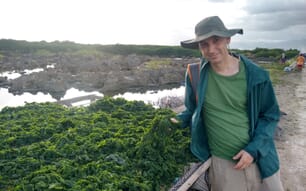On May 15 the fleet of more than 570 fishermen set out their nets on a beautiful day for the first 12 hour opener amidst the usual hype for the first fish.
“We’ve got a lot of people riding around in the sky checking out the conditions, and a lot of people are getting ready to move the fish to other places for First Fish celebrations,” said Kim Ryals, executive director of the Copper River/Prince William Sound Marketing Association.
Out on the fishing grounds, it was a “very slow day, to say the least,” according to veteran high liner Bill Webber of Cordova.
“Even with the warmer environmental conditions we had this spring, I think we are in front of the run,” Webber said. “I just hope we stay on the return trend we have been enjoying in recent years. Well, it is the first period and we have to get a few more to see the trend for this year.”
Prices for the first fish dipped a bit – Copper River Seafoods posted advance sockeye prices at $3.50 and $6.00 for kings; that compares to $4.00 and $6.00-$7.00, respectively, for last year’s opener.
In what has become a traditional rite of spring, Alaska Airlines whisked away the first 24,000 pounds of the famous fish to Seattle where pilots traversed a red carpet to hand deliver a 48 pound king salmon to three chefs for a cook-off at Sea-Tac Airport. At least five other jets carried fresh fish from Cordova to eager buyers throughout the US, as well as to Anchorage.
“This year, along with sending salmon to high end markets in Seattle and the Lower 48, the first fish also will be enjoyed closer to home,” said Kim Ryals.
Several events are planned in Anchorage, she said, and fishermen also are donating salmon to a new shelter called Clare House.
“It is for women and children and pregnant women over 18,” Ryals said. “We feel like we have so much to be thankful for here in Cordova with our rich natural resources that we want to share some of these things with the people here in our own state.”
A special locator app tells where Copper River salmon is being sold, and customers also can upload information. www.copperriversalmon.org
The Copper River forecast calls for a catch of 1.8 million sockeyes and 33,000 kings this summer.
Seeing red - Red salmon from the Copper River are a unique brand that fetch an average premium of nearly $2 a pound above all other sockeye salmon in US grocery stores. The average price of “unbranded” sockeye was $10.23/lb during the past year, according to a market analysis by the Juneau-based McDowell Group. The report was done for Bristol Bay fishermen, but it covers all regions and markets.
Sockeyes are by far Alaska’s most valuable salmon, typically worth about two-thirds of the total statewide salmon haul. But in terms of global supply, wild sockeye are rare creatures - they account for about 5 percent of all wild and farmed production, and represent just 15 percent of the world’s wild salmon harvest.
Alaska typically accounts for 70 percent or more of global sockeye production, with nearly half of that coming from Bristol Bay. The U.S. is the single largest market, purchasing nearly 44 percent by value in 2012. Japan and the U.K. are next, followed by Canada.
The McDowell report said it will be increasingly important to defend the Alaska sockeye brand from “craft” farmed salmon producers. Niche producers, such as Verlasso and Skuna Bay have a big advantage because they can offer fresh salmon on a year-round basis. The high end fish farmers also message their salmon as being sustainable, environmentally friendly and “harmoniously raised.”
Alaska’s sockeye salmon catch this year is projected at nearly 34 million fish, five million more than last year. Average statewide price last year was $1.60, an increase of 30 cents from 2012.
Going grey - As older fishermen retire from the business, fewer young people are recruiting in. The average age of Alaska permit holders is 47 -- and there are twice as many permit holders aged 45 to 60 as there are between 30 and 44.
The issue – dubbed the Graying of the Fleet – has been discussed for years. Now an ambitious project is underway to find ways to overcome the obstacles facing young recruits.
Armed with a $335,000 grant from the North Pacific Research Board, a multi-year project is underway to focus on young fishermen in the Bristol Bay and Kodiak regions.
“We are really going to be diving into some of the factors that allow young people to be successful and what motivates them to stay in the business, and what are some of the challenges and solutions to make it easier for young people to live, work and be successful as fishing business owners,” said Kelly Harrell, director of the Alaska Marine Conservation Council who has teamed with Alaska Sea Grant for the project.
The “Graying of the Fleet” project will include interviews with permit holders, processors and other stakeholders in an attempt to come up recommendations. It will be completed in August 2016.
Weed power! “When the tide is out, the table is set” is an Alaska Native saying. Now scientists at North Carolina State University have found that seaweeds commonly found in waters and beaches near Sitka are packed with compounds that can protect against obesity, diabetes and cardiovascular diseases.
The researchers said there is nothing on grocery shelves that can compare to the levels of antioxidants and other healthy compounds seen in Alaska seaweeds, which have to be really tough to withstand strong tides and temperatures. That results in ‘more bang for your buck,’ and the Alaska seaweeds produce much stronger chemical defenses than commercially grown fruits and vegetables.
In a presentation at a biology conference in San Diego last week, lead seaweed scientist Joshua Kellogg showed how the high levels of “bioactive phytochemicals” in Alaska seaweeds appear to combat the chronic inflammation that causes obesity, diabetes and heart disease. Find more information in the Journal of Agriculture and Food Chemistry.





